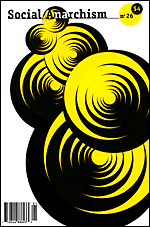Crimes of Style
Crimes of Style: Urban Graffiti and the Politics of Criminality by Jeff Ferrell, 236 pp. Boston, Massachusetts: Northeastern University Press, 1996. $20.00 paper.
We are so perverted by an education which from infancy seeks to kill the spirit of revolt, and to develop that of submission to authority; we are so perverted by this existence under the ferrule of a law, which regulates every event in life — our birth, our education, our development, our love, our friendship — that, if this state of things continues, we shall lose all initiative, all habit of thinking for ourselves.
Kropotkin, "Law and Authority" 1886
Ferrell takes us on a detour from the mainstream and invites us into the neighborhoods of the graffiti artists of Denver. We roam the freight yards and warehouses with them, bum cigarettes from them, share swigs of Jack Daniels with them, and listen to their hearts. I could smell the after-fumes and kept checking my hands for wayward spray as I traveled the urban turf, dodging the authorities and squinting in the moonlight at a still-wet, drip-less masterpiece.
In the first two chapters, Ferrell places the emergence of graffiti art in a social, political, historical and geographic context. He provides the reader with a quick history of contemporary urban cultural influences and responses. Graffiti is part of a larger aesthetic, characterized by a sort of rebellious and innovative use/non-use of technology. The urban poetry of hip-hop, characterized by street-based rappers talking about their reality, accompanied by synthesizer and turn-table squawks led inevitably to a visual- word art form. From New York to Denver, the earliest influences of graffiti art in Denver are traced to a young man named Z-13, in the 1980's. This is a technically outlawed, underground art form, and an art form driven by communication. It is as much by the artists who do it as for one another. If the public happens to like it or not like it, that's irrelevant. In fact, the "public" doesn't even see much of this art; the "towering inferno" is a multi-floor abandoned warehouse in Denver where spectacular graffiti works appear and evolve on the inner walls, unseen by all except the writer/artists, trespassers by law.
Ferrell presents and identifies the anarchist attributes of this community. Through the voices of its veteran members, identified by their tags, emerges a moral code. On stealing, Z-13 says, "I've never stolen paint. As far as that goes, I don't think anybody in this scene has ever done that." Another artist, Fie, says, "I stole one can of paint. And I must've bought — you know, I saved, I used to save my tips (nozzles), and you know, I bought at least 500 cans of spray paint…(you) work a part-time job to pay for your crime."
Out of respect for natural beauty, the artists avoid doing graffiti in the central green park. Eye Six says, "Green, growing grassland. And people, you know, they want to get away. It's in the middle of the city, and they want to get away from the urban, they don't want to see no fuckin' graffiti. They want their kids to run around…(Instead), I go out where the winos are, where the bums are, and where it's rotting, and fucked up, and I beautify it." Indeed, most of the artists will not do graffiti on granite walls or sculptures, and won't do graffiti on a clean spot, out of respect for "somebody's wall" or "somebody's garage". They voice concern for the safety of others in their disdain for the "huffers", those who scavenge leftover empty cans for fumes to get high. Many of the artists themselves wear filter masks and de-activate the discarded cans so that they cannot be used by the self-destructive. The artists travel by public transportation and then on foot at night, carrying portable sketchbooks and using crates and debris as ladders to quickly produce what are often well-thought out, elaborately planned statements of color and word. Indeed, graffiti production is an endless public conversation between the artists commenting on one another's work or asserting identity or resistance.
All of this is made more accessible by the inclusion of photographs by Eugene Stewart-Huidobro. The black and white photos are in the heart of the book and allow us to examine not only the graffiti but the texture of the paint and the walls it sits on and some of the artists at work. There is a lovely panoramic view of the "wall of fame" stretching across the rail yards with the city in the background. The photos are an absolutely integral part of the book.
The "Crime" part of the book was weaker than the "Style" part. As a defense lawyer for indigents in an old mid-size city, I have never come across a prosecution for vandalism, to wit: graffiti. There doesn't seem to be much around here. Not a very artistic lot, our poor. Mainly, their criminal activity seems to center on walloping women and using drugs. So, I was curious about the prosecution of graffiti cases and the criminal dimension of graffiti artistry, and, unfortunately, I still am.
Apparently there is an urban beautification movement afoot in Denver which is hell-bent on quashing graffiti there. All manner of elected and appointed officials use the presence of graffiti in the city to rally the citizenry to support policies aimed at punishing the artists or whitewashing the "affected" areas. Ferrell compares this movement to the larger Christian Right and presents examples from editorials and televised campaign commercials in which their panic and dismay about the graffiti frequently takes on a moral tone. He admonishes those (like myself) who would belittle or be amused by their reaction that we should watch out — that this Christian Right thing is big and serious. Meanwhile there are glitzy gallery dealers wining and dining the selected artists of the street at very public exhibitions. Artists are selling their graffiti and will do graffiti on your car or shoes or clothes for a price.
So, where is the crime? I guess it's a crime because it's on the books as a crime, and it can be used to chase down and hound street people. There is some discussion of fines and penalties such as community service, but I just don't get the feel of the criminal dimension.
Part of the purpose of this little book is to document seemingly every living graffiti artist in Denver. Details such as what one artist says about another's work or who "influenced" him might be important to preserve as a historical record, but, unless the reader regularly hangs with these guys and is getting off on seeing their names in print or unless one is doing a thesis on some aspect of graffiti, the average reader will be left a little bored with this approach. Fortunately, this shortcoming is not fatal to the book.
Ferrell's loving and capable hands do not allow the graffiti artists to perish on the sociological dissecting table, and all their rambunctious qualities come through.
In the final chapter of this book, Ferrell sums up the meaning of a small defiant group of artist/writers versus the moral entrepreneurs fueling enforcement and punishment. Concepts of the individual, private property, authority, "representative politics" and direct action are examined, as they relate to the aesthetic of this temporary street-art-life process. And Ferrell identifies and reminds us of an important anarchist quality — humor. The age-old anarchist method of not only defying, but also poking fun at authority is presented, and the graffiti artists are consistent with this tradition.
In the end, Ferrell presents a case for injecting anarchist thought into criminology, the need for laying bare the mythologies of the legal system, and the institutionalized injustice. Recent examples that come to my mind are the amusing debate in the mainstream media about how drug "forfeiture" laws benefit the rich and unfairly penalize the poor (as though criminal punishments would be meted out evenly amongst the class strata in defiance of every other capitalist institution), the debate about state-sanctioned murder for those convicted of killing, a.k.a. capital punishment, and thinly disguised race-based legislation of mandatory jail time for quantities of crack cocaine that are so immeasurable that they can only be labeled "residue".
In closing, Ferrell does what he set out to do: examine a small microcosm of urban culture and extrapolate onto the larger society. I liked the book a lot and look forward to more of Ferrell's useful contributions to anarchist thought and action.
Read this book.

